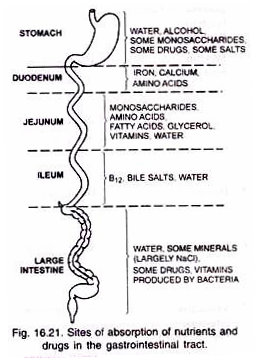ADVERTISEMENTS:
In this article we will discuss about the Roles of Absorption in Different Nutrients.
1. Absorption of Monosaccharide’s:
All carbohydrates are absorbed as monosaccharide’s in stomach and jejunum. Glucose and galactose are absorbed by active transport. Sodium pump of the cell membrane helps in its active take up.
ADVERTISEMENTS:
Fructose is absorbed by facilitated transport. Glucose, galactose and fructose are absorbed into the blood capillaries. The most rapidly transported monosaccharide is galactose with glucose running a close second.
2. Absorption of Amino acids:
Amino acids are absorbed by active transport and some amino acids are absorbed by facilitated transport. It occurs mainly in the duodenum and jejunum. Normally 95-98% of amino acids are absorbed in the small intestine. They also enter the blood stream (Fig. 16.22).
3. Absorption of Fatty acids and Glycerol (= Absorption of fat) and fat soluble vitamins:
All these nutrients are absorbed via simple diffusion. Fatty acids and glycerol are insoluble in water, therefore, they cannot reach the blood stream directly. They are first incorporated into small, spherical, water soluble droplets called micelles with the help of the bile salts and phospholipids in the intestinal lumen.
A micelle is an aggregate of many molecules. From the micelles fatty acids, glycerides, sterols and fat soluble vitamins are absorbed into the intestinal cells by diffusion where they are resynthesized in the ER and are converted into very small fat molecules (droplets) called chylomicrons.
The latter are released from the intestinal cells into the lymph present in the lymphatic capillaries, the lacteals. Small quantities of short chain fatty acids are absorbed directly into the blood by diffusion rather than into the lymph. Fatty acids, glycerol and vitamins are absorbed in jejunum.
4. Absorption of Water:
About 90% of all water absorption occurs in the small intestine by osmosis from the lumen of the small intestine through epithelial cells and into the blood capillaries in the villi. The absorption of water from the small intestine is associated with the absorption of electrolytes and digested food in order to maintain an osmotic balance with the blood. Absorption of water also occurs in the stomach and the large intestine.
ADVERTISEMENTS:
5. Absorption of Salts (Electrolytes):
Sodium is absorbed from small intestine by active transport. This process is coupled to the movement of glucose, as mentioned earlier. Several other ions, including calcium, potassium, magnesium, iron and phosphate are absorbed by active transport. Calcium absorption is enhanced by vitamin D and parathormone (hormone secreted by parathyroid glands).
Chloride ions can be absorbed by diffusion or active transport. Salts are also absorbed into the blood capillaries. Most ions are actively absorbed throughout the small intestine. Calcium absorption is mainly limited to the duodenum. Almost all iron absorption occurs in the duodenum. Bile salts are absorbed in ileum.
6. Absorption of Water Soluble Vitamins:
ADVERTISEMENTS:
Most of water soluble vitamins such as the vitamin В complex, vitamin С and vitamin P are absorbed by simple diffusion into the blood capillaries. But reabsorption of vitamin B12 requires combination with Castle’s intrinsic factor produced by the stomach for its absorption.
7. Absorption of Alcohol:
Because alcohol is lipid soluble, it begins to be absorbed in the stomach. However, the surface area for absorption is much greater in the small intestine than in the stomach, so when alcohol passes into the duodenum, it is absorbed more rapidly.
Thus amino acids, monosaccharide’s, short chain fatty acids, minerals, water soluble vitamins, and water are absorbed into the blood and fatty acids, glycerol, glycerides and fat soluble vitamins are absorbed into the lymph.



